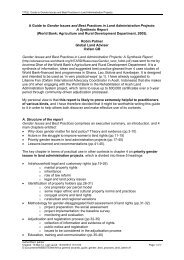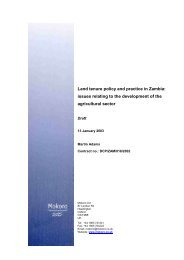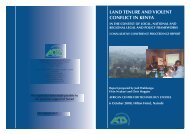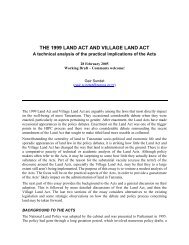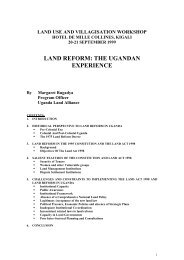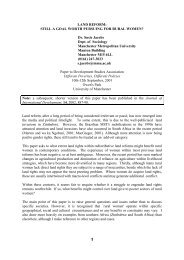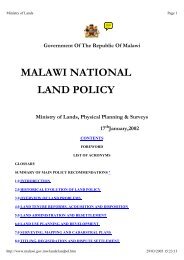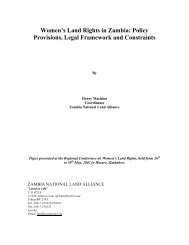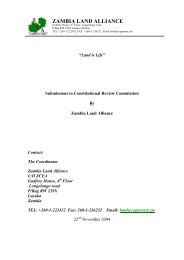Download - Mokoro
Download - Mokoro
Download - Mokoro
- No tags were found...
Create successful ePaper yourself
Turn your PDF publications into a flip-book with our unique Google optimized e-Paper software.
244. LIVELIHOOD IMPACTS OF LAND USES IN LANDREFORMIt is essential to understand how land use has impacted on the livelihoods of land reformbeneficiaries, however available information is neither comprehensive, nor agreed onindicators. The South African literature on land reform suggests that outcomes, orindicators, of success in land reform should include: Improved food security improved nutritional status from self-provisioning, alsoresulting in increased disposable cash income; More income; increased regularity of income from marketed produce, wageemployment; and more egalitarian distribution of income; Increased well-being: improved access to clean drinking water and to sanitation,improved housing, ownership of household items and access to fuel for cooking;Reduced vulnerability: improved access to social infrastructure, like schools andclinics, increased mobility; More sustainable use of the natural resource base (Andrew et al 2003, DLA 1997,May and Roberts 2000).The Quality of Life (QOL) surveys conducted by the DLA have provided some, limited,insights into the land uses and livelihoods of land reform beneficiaries. The QOL surveyswere initially envisaged as annual surveys, later as biannual surveys, and have inpractice been published in 1998, 2000 and 2003, with a fourth survey being in processduring 2007, for which results are expected to be available during 2008. The DLAcommissioned the QOL surveys to investigate the extent to which the objectives of theland reform programme have been met and the surveys claim to provide “an account ofthe impact of land reform on the livelihoods of land reform beneficiaries” (DLA 2003:xx).The first survey was a small study conducted internally by the DLA’s Monitoring andEvaluation Directorate, and published as the “Annual Quality of Life Report” in October1998. This survey, conducted in 1997-98, “was widely criticised for its limited scope, itsquestionable theoretical assumptions and its methodology” (Naidoo 1999).“An independent assessment of the report concluded that the study wasnot sufficiently detailed to permit the assessment that was required byDLA. The assessment also questioned the sampling procedures thatwere used, and the way in which these were implemented raising theconcern that the study may not be representative or sufficiently rigorousfor the purposes of monitoring” (May and Roberts 2000).The second survey attempted to assess the impact of reform on livelihoods, though thiswas shortly after transfer – more than half the projects had been transferred less than ayear prior to the survey (May and Roberts 2000). The survey found widespread underutilisationof land, both in the sense of land not being used at all, and land that waspotentially arable being used for less intensive forms of production: “much land remainsunder-utilised, with neither grazing or cultivation occurring”; and “the most common formof productive use is as grazing land” (May and Roberts 2000:8,13).Policy Options for Land and Agrarian ReformProgramme for Land and Agrarian Studies, University of the Western Cape




